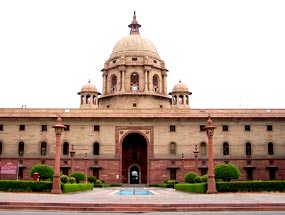Rashtrapati Bhavan of New Delhi serves as the
official residence of the President of India.
Rashtrapati Bhavan

Location: New Delhi
Architect: Edwin Lutyens
Rashtrapati Bhavan is the name given to the official residence of the
President of India. It is situated in New Delhi, near the magnificent
India Gate. Before India's independence, the Bhavan used to serve as the
residence of the Governor-General of India and was known as the
'Viceroy's House'. This name continued to be used even after
independence and it was only in the year 1950 that it was changed to
'Rashtrapati Bhawan'. The area in which this monument is situated is
known as Lutyens' Delhi.
It was in the Delhi Durbar year of 1911 that the decision to shift the
capital of India to Delhi was taken. British architect Edwin Landseer
Lutyens was hired to design and build the entire area of New Delhi and
within it, the Governor-General's residence that later came to known the
'Viceroy's House'. Along with Edwin, Herbert Baker was appointed to work
as the architect of the Rashtrapati Bhawan. It was also decided that the
architecture of the President's House would be basically classical, but
with an Indian motif.
The monument is entered through Gate 35, which is located on Prakash
Vir Shastri Avenue. The top of the monument seems to be crowned with an
ancillary dome-like structure, known as 'Chattri'. The eastern facade of
the monument has twelve unevenly spaced columns, with the Delhi order
capitals. A blend of acanthus leaves and four pendant Indian bells, one
on each corner, adorn these capitals. The front portion of the
Rashtrapati Bhavan is devoid of windows, except for the wings at the
sides.
The monument, then 'Viceroy's House', was completed in the year 1929
and its official inauguration ceremony took place in 1931. It took
approximately seventeen years to complete the magnificent building and
on the eighteenth year after its completion, India attained
independence. After independence, the ceremonial Governor-General
continued to occupy the building. It was in 1950 that India became a
republic and nominated the first president, who took over the 'Viceroy's
House' and renamed it as the 'Rashtrapati Bhavan'.
Apart from the Indian style, one can also see Mughal and European
colonial architectural elements in the construction of the building.
There are 340 rooms in the Rashtrapati Bhawan, which cover a floor area
of 200,000 square feet. 700 million bricks and 3 million cubic feet of
stone were used for constructing the edifice, which has only minimal
usage of steel. The entire building has been built around huge
courtyards, with a number of squares and open inner areas within. The
president stays in a separate wing, while the guests stay in another
wing.
There is a Viceroy's wing, meant to be used by the president. However,
it is so flamboyant that the first president of India decided not to
stay there. He stayed in the guest wing and so have all his successors
till date. The wing is a separate four-floor apartment, having its own
courtyards. The heart of the President's House comprises of the Durbar's
Hall, which was initially the 'Throne Room' housing the thrones for the
Viceroy and his wife. The hall has columns made by combining vertical
lines with the motif of a bell.
There is a 2-ton chandelier in the hall, which brightens up its
otherwise simple interiors. There is one room in each corner of the
hall, comprising of the two state drawing rooms, a state supper room and
the state library. The hall serves as the venue of all the official
ceremonies, such as the swearing in of the Prime Minister, the Cabinet
and the Members of Parliament. The President of India also gives away
the Arjuna Awards for Excellence from the confines of the Durbar's Hall
only.
The interiors of the Durbar's Hall as well as most of the other rooms
of the Bhawan are quite simple. Heavy stonework and shapes have been
used to present an image of simplicity rather than elaborate
ornamentation. Other rooms inside the Rashtrapati Bhavan include State
Dining Hall, Sitting Rooms, Billiards Rooms, State Ballroom, State
Drawing Room, etc. Near the Viceroy's stairs, we see eight marble lions
spilling water into six basins.
The main dome of the President's house involves a fusion of Indian and
British architectural styles. The Jaipur Column is situated in the
center of the main court in front of the President's House. It is
approximately 145 meters high and was received as a gift from the
Maharaja of Jaipur. Surrounding the Bhawan are the exceptionally
charming Mughal Gardens. The base of the President's House has a huge
courtyard, known as Vijay Chowk.
Trivia
The President of India does not occupy the Viceroy Wing; rather he
stays in one of the guestrooms. This trend was started by the First
President of India, who found the Viceroy Wing too ostentatious.
Rashtrapati Bhavan is the biggest President's residence in the whole
world.
The Rose Garden of Rashtrapati Bhavan is open to public every year, in
the month of February.
Steel was not used in the construction of the Rashtrapati Bhavan.


